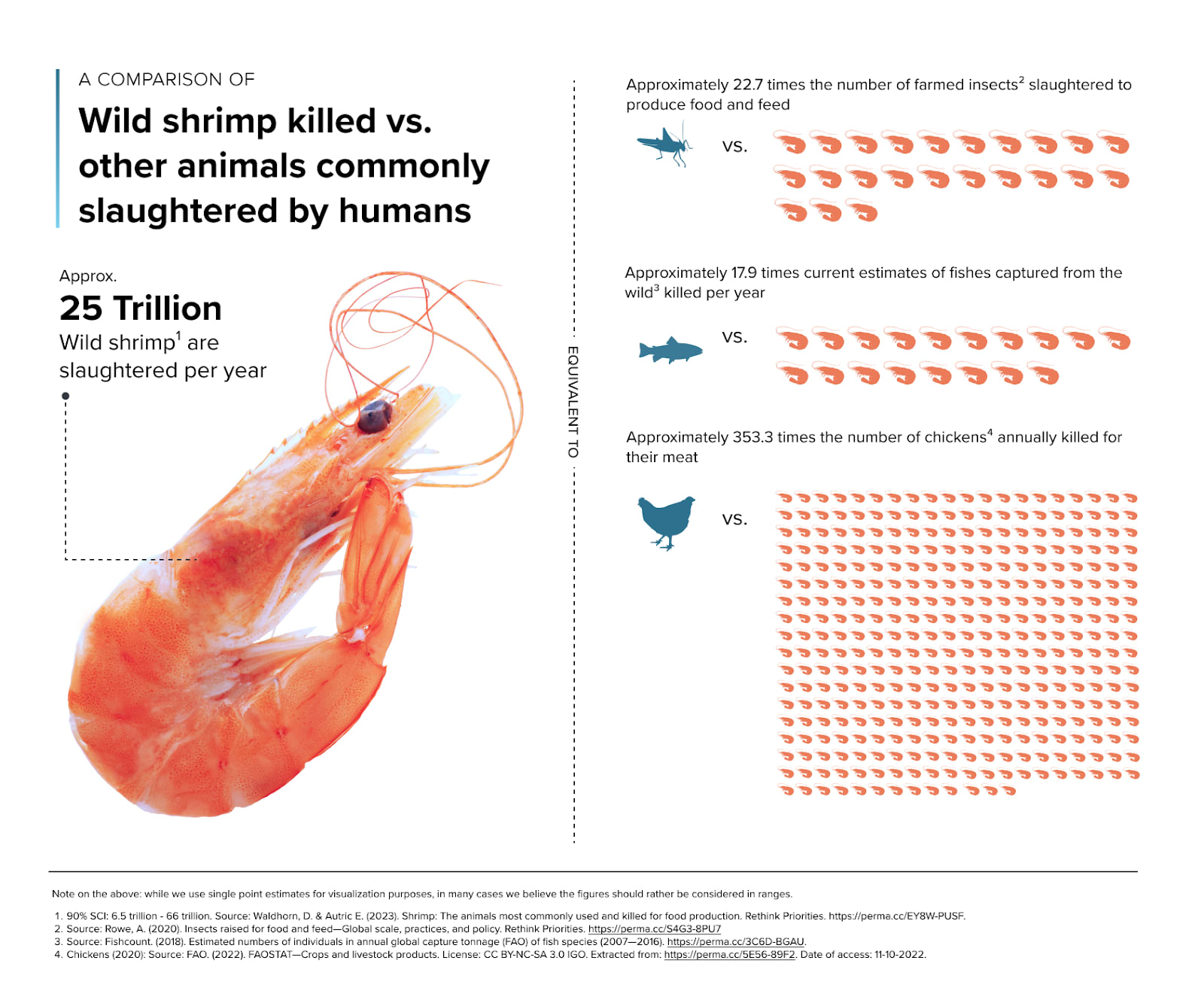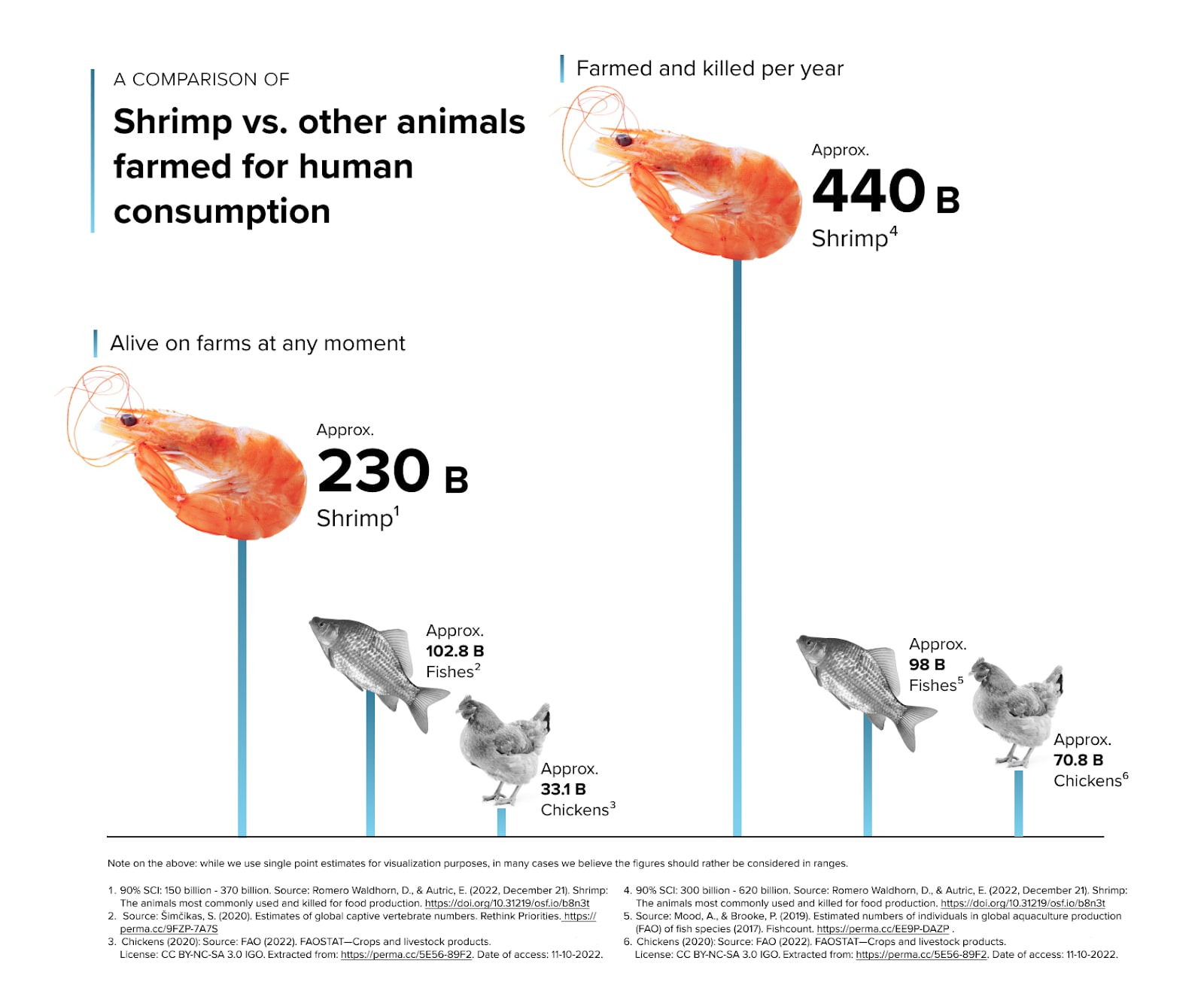Rethink Priorities' Shrimp Welfare Sequence
Human consumption of shrimp has increased rapidly in recent decades. Yet, there are few requirements or guidelines for how farmers and fishers should treat shrimp used for food. Rethink Priorities is completing a series of reports, the Shrimp Welfare Sequence, to orient readers to a nascent field dedicated to incorporating welfare considerations into shrimp production. Below, we provide an overview of the reports that are either complete or currently in progress.
Why Shrimp?
Is protecting the welfare of shrimp a worthwhile goal? Few studies have tested whether shrimp are sentient– i.e., capable of having positive or negative experiences– and some commentators are skeptical about existing confirmatory evidence (Crump et al., 2022; Diggles, 2023). Given indefinite uncertainty about shrimp sentience, the Animal Sentience Precautionary Principle provides criteria for how to proceed:
Where there are threats of serious, negative animal welfare outcomes, lack of full scientific certainty as to the sentience of the animals in question shall not be used as a reason for postponing cost-effective measures to prevent those outcomes. (Birch, 2017, p. 3; emphasis is ours).
Accordingly, our goal is to assess whether shrimp used for food face serious and negative welfare threats. Upon determining that the animal sentience precautionary principle is indeed applicable, we also want to identify cost-effective measures to mitigate negative outcomes in shrimp production.
The Scale of Potential Harm
The number of individuals affected by shrimp production is a key metric for the seriousness of potential welfare problems (Birch, 2017 p. 4). Hence, our first report estimated how many shrimp are used for food each year. By converting data on the biomass of animals slaughtered each year to numbers of individuals, we find that wild-caught shrimp represent the majority of animals directly killed for food each year (~25 trillion). Meanwhile, we find that there are more shrimp alive on farms at any time than any other type of animal (~230 billion).
Of course, if farmers and fishers treat shrimp well, then the large scale of production would not necessarily pose a welfare issue. However, suffering might be quite common, at least on farms. In particular, pre-slaughter mortality rates across a range of sources indicate that over half of farmed shrimp die before farmers deem them ready for slaughter.
Welfare Threats on Farms
Why are shrimp so vulnerable on farms? We provide an overview of shrimp aquaculture to contextualize the answer. Although farming practices are highly heterogeneous, they vary on a continuum from "extensive" to "intensive." Extensive farms construct ponds near a water source where wild shrimp drift in due to the tide, where they remain confined due to dikes and screens. Extensive farms stock shrimp at low densities because the ponds have a limited amount of oxygen and food. Welfare issues on extensive farms are in large part due to a failure to control external threats, such as predation and environmental pollutants from other farms.
Welfare issues on intensive farms, on the other hand, largely result from attempts to control the aquatic environment. In particular, intensive farmers employ technology and proactive management practices to increase aeration and food availability, allowing them to stock shrimp at higher densities. Higher densities result in greater amounts of leftover food and excrement, which can cause toxic levels of ammonia and hydrogen sulfide. Intensive farmers try to solve these issues, but in doing so create yet more welfare problems. For example, lining the bottom of the tank with plastic prevents the buildup of sludge, but it also prevents shrimp from burrowing, a potentially rewarding behavior. Even putting its effects on water quality aside, crowding increases cannibalism, disease transmission, and limits access to resting areas.
Pre-slaughter mortality
In an upcoming report, we explore a cause for concern and indicator of poor welfare: a large percentage of these individuals die before they are old enough to be slaughtered. We compare farmed shrimp pre-slaughter mortality with that of other farmed species to better understand trends and possible causes.
Ranking Welfare Threats
Which of these issues is most concerning? We adapt Welfare Footprint's pain-track framework (Alonso & Schuck-Paim, 2021) to model the scale of each threat according to its duration, severity, and prevalence.
Interventions for Immediate Consideration
With so many negative outcomes affecting so many shrimp, postponing interventions to improve shrimp welfare risks unnecessary harm to billions of individuals each year. The Animal Sentience Precautionary Principle dictates immediate action, but what cost-effective interventions are available? Our next report outlines opportunities to help shrimp and distills lessons from interviews with several organizations who have worked to advance shrimp welfare.


